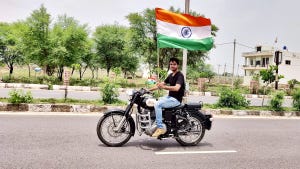Huawei hails 9% sales growth as Ericsson and Nokia shrink
The sanctions-hit Chinese vendor says it has weathered the storm and that its devices unit beat expectations this year.

The festive period is never complete without a premature New Year message from Huawei, the embattled Chinese equipment vendor whose fortunes have dived because of US sanctions. Aimed at customers, employees and partners – and clearly designed to catch the eye of the media – it has recently struck a defiant tone, and the update issued on the eve of 2024 is no different. But its resounding point is of revival after several years of US-manufactured turbulence.
"After years of hard work, we've managed to weather the storm," said Ken Hu, the rotating chairman who currently occupies the management slot. "In 2023, we expect to wrap up the year with over 700 billion yuan [US$98.9 billion] in revenue." That number is the big reveal in a message otherwise light on valuable content. It would mark a 9% increase on sales last year, when the comparable rate of growth was less than 1%. And it would have come in a difficult year for equipment makers throughout the sector.
It would, however, still be a fifth less than Huawei made at its apex in 2020, before it was clobbered by US rules cutting it off from vital components. Worst of all was the loss of access to TSMC, a Taiwanese semiconductor foundry responsible for most of the planet's most sophisticated chips. Huawei designs many of the chips that go into its gadgets and network equipment. But it relies on foundries to produce them. And the US has forbidden any foundry that uses American tools or software from supplying Huawei. As a big customer of US companies like Applied Materials, which makes the machines used in chip factories, TSMC quickly acquiesced.
Hence broader Chinese efforts to be more technologically self-reliant. While China has foundries of its own such as SMIC, other international rules have cut them off from an important technology called extreme ultraviolet lithography (EUV), which effectively imprints silicon wafers with circuit designs measuring just a few billionths of a meter (nanometers). A predecessor known as deep ultra-violet lithography (DUV) is good for slightly larger designs, but cutting-edge chips ideally need EUV.
Unfortunately, for Huawei and China, the Netherlands-based ASML today enjoys an EUV monopoly, and its government has denied ASML export licenses to serve China. Experts doubt China will be able to develop a homegrown alternative for years. There was some amazement, then, when teardowns showed that a Huawei smartphone announced in September – the Mate 60 Pro – included 7-nanometer chips.
In all likelihood, those chips were supplied by SMIC and made with DUV machines and a technique known as double patterning. This EUV workaround is fine if the objective is to churn out the odd 7-nanometer or even 5-nanometer chip. The doubt is whether SMIC would be able to produce the chips needed for mass-market sales of the Mate Pro 60 without incurring losses.
Little clarity on the moving parts
Unclear from Huawei's latest update is what might have driven the 9% sales growth it expects this year. But there are some clues in the first paragraph of Ken Hu's commentary. "Our ICT infrastructure business has remained solid, and results from our device business surpassed expectations," he said. "Both our digital power and cloud businesses are growing steadily, and our intelligent automotive solutions have become significantly more competitive."
No specific mention, then, of the carrier business that makes network equipment, Huawei's oldest unit. Judging by results from Ericsson and Nokia, and a weak appetite for upgrades among large international telcos, this seems unlikely to have buoyed sales growth in 2023. Ericsson's revenues for the first nine months fell 7% on a constant-currency basis. Nokia's were down 3%. And although neither has much exposure to China, where Huawei generated 63% of its revenues last year, the rollout of 5G by China's mobile operators was already well advanced at the start of this year.
The suggestion in the chairman's statement is that Huawei owed most of the improvement to the surprise performance of its devices business. In 2020, this consumer unit accounted for about 54% of all Huawei's revenues, but its sales halved the following year. It was badly hurt by sanctions because smartphones have a greater need than networks do for advanced chips. Huawei was also cut off from Google software that runs on other Android smartphones. Its response to all this included the sale of Honor, a big smartphone subsidiary.
Could early interest in the Mate Pro 60 help to explain the recovery? Possibly, according to recent data from Counterpoint Research. In a blog published in the run-up to Christmas, the market research company rated the new Huawei gadget as the second-most popular smartphone model in China during October, behind Apple's iPhone 15 Pro Max. Company sources say orders have been high. The key, given semiconductor issues, may be Huawei's ability to keep up with demand and do so profitably.
Nothing on the bottom line
Diversification into areas such as cloud computing and enterprise software has previously helped to boost sales in China for Huawei. It would be a surprise if the Chinese vendor had not been able to record further gains at these relatively small business groups in 2023. What's missing from Ken Hu's New Year message is any reference to company profits, which plummeted 69% last year, to just RMB35.6 billion ($1 billion).
Huawei watchers will probably have to wait until the publication of its 2023 annual report for an update there. But senior bosses are evidently being more prudent about costs. "We will continue to streamline HQ, simplify management, and ensure consistent policy, while making adjustments where necessary," said Huawei's chairman.
Headcount was up from 195,000 in 2021 to 207,000 last year, while other technology firms were trimming staff numbers. But Huawei seems determined to pump even larger sums into research and development than it did before. Around RMB161.5 billion ($22.8 billion) was spent on this activity in 2022, about a quarter of total revenues and a 13% year-over-year increase. That largely explained the collapse in profitability. But for any company in the same game, it's a big and scary figure.
About the Author(s)
You May Also Like












